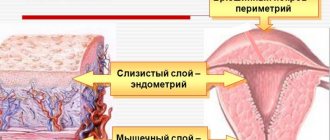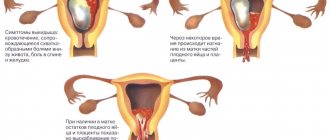Planning a pregnancy and the birth of a child does not always end favorably. Sometimes a woman has to experience a miscarriage for various reasons.
Cleaning after a miscarriage is an unpleasant but necessary procedure that can rarely be avoided. Some believe that the consequences of curettage will be more disastrous than the miscarriage itself, and are afraid of curettage (removal of the upper mucous layer). However, in most cases this cannot be avoided.
Curettage procedure after miscarriage
The manipulation takes 15–20 minutes. A preliminary referral is given for a coagulogram and general blood tests, testing for infections. Cleaning after an early miscarriage (up to 12 weeks) is carried out if, according to ultrasound, fragments of the fertilized egg are detected in the uterus.
You should not take food or liquid 8–10 hours before surgery. The curettage procedure takes place on a gynecological chair: the genitals are disinfected with an antiseptic, the cervix is dilated and the mucous layer is scraped out with a vacuum or curette. These manipulations are quite painful and are performed under anesthesia - local or general. If possible, hysteroscopy (examination with a video camera) is performed simultaneously with curettage: curettage after a miscarriage is considered the least dangerous when the doctor sees the uterine cavity.
If there is an early miscarriage, the embryo may come out entirely (it looks like a gray round bubble), then cleaning is not required. In other cases, fragments of the fetus will begin to decompose, which will give rise to the spread of pathogenic microbes and damage to the lining of the uterus. Therefore, even if a miscarriage occurs outside a medical facility, and the woman is sure that the embryo has been released completely, you should not neglect a visit to the doctor.
What medications will you need first?
If the termination of pregnancy occurs spontaneously with complete removal of the fertilized egg, then no medications are prescribed after this (except in certain situations). When curettage was performed after a miscarriage, the gynecologist prescribes appropriate medications. Among them, the most popular are the following:
- Antibiotics (preference is given to penicillins and macrolides, other groups are prescribed less frequently). Bacteriostatic and bactericidal medications are prescribed to prevent infection. Often such consequences arise from cleaning. You need to take antibiotics for 3-10 days in accordance with the doctor’s recommendation.
- Uterine remedies (most often they use Oxytocin or medications based on it). These drugs enhance the contractility of the myometrium. Due to this, the mucous layer is quickly rejected, preventing extensive bleeding and speeding up the recovery process.
- Immunomodulators (“Isoprinosine”, “Derinat”). These drugs increase the body's resistance; they are also intended to eliminate viral infections obtained during or after curettage.
Any medications after a miscarriage should be prescribed by a doctor. Self-administration of drugs can be fraught with unpleasant consequences. Don't listen to experienced friends. Trust only your gynecologist.
Cleaning after early miscarriage
Pregnancy interrupted immediately - at 5-8 weeks - is not uncommon. The doctor must find out the cause and inspect the uterus so that the infection does not penetrate the genital tract. In the early stages, spontaneous miscarriage can occur without cleaning.
If, after an unexpected termination of pregnancy, the fertilized egg is expelled entirely, there is no need to curettage the uterus. The specialist makes a decision based on the results of tests and ultrasound. Inspection of the uterus is also carried out during a frozen pregnancy.
The mucous membrane is scraped out for the purpose of prevention in case of bleeding, accumulation of blood clots, so as not to leave pieces of the fertilized egg.
If necessary, curettage of the upper layer of the mucous membrane of the uterus and its cervix is performed. Samples are sent for histology to determine the cause of the miscarriage.
What does a miscarriage look like?
In the first days, an interrupted pregnancy looks like normal menstruation. Only a few days have passed since fertilization; the embryo has not yet had time to securely attach itself in the uterus. It is useless to look for photos of such miscarriages. In 90% of cases, women did not even suspect that they were pregnant.
At 2-3 weeks, the fertilized egg is 1-2 centimeters in diameter. A woman suspects pregnancy because she notices a delay in her period. Tests can confirm it. But ultrasound is not always able to discern such a small fetus. A miscarriage may look like a heavier period. Some manage to see something in their discharge; you can find amateur photographs on the Internet, and corresponding pictures on medical websites.
Every week the fetus “grows” in volume by 1 millimeter. At a period of more than two weeks, a blood clot approximately corresponding to the size of the embryo can be detected in the discharge. The color of the discharge may be the same as during menstruation, or brighter.
Caution! At later stages, from 7-9 weeks onwards, there are two or more clots. This is due to the fact that when rejected and released from the uterus, the fertilized egg may disintegrate into separate pieces. More often, the fetus comes out entirely; some women claim that they were able to see the details of the embryo body and the umbilical cord.
Consequences of cleaning after a miscarriage
Like any intervention, cleaning the uterus during a miscarriage is not always without complications. If there are problems with blood clotting, uterine bleeding may occur. To stop it, oxytocin injections are prescribed.
Abdominal pain and fever are signs of an ongoing inflammatory process. Due to spasms of the cervical canal during curettage, blood clots may accumulate in the uterus.
A circulation disorder is called a hematometra. Accumulating in the uterine cavity, blood cannot escape, causing painful attacks. If you ignore this diagnosis, you may subsequently lose your uterus and the possibility of childbearing.
A complication of hematometra is blood poisoning, which can be fatal. Doctors prescribe medication and special procedures to remove accumulated blood from the uterus as therapeutic methods.
After cleansing as a result of spontaneous abortion, complications may appear in the form of endometritis, in which the mucous membrane becomes inflamed. Therefore, a course of antibiotics is necessarily prescribed, which is important to complete according to the regimen.
Vacuum cleaning of the uterus after a miscarriage is the most effective and safest method of curettage. But in some cases problems may arise:
- Not completely removed embryo. The doctor often has to manipulate blindly, so there may be remains of the fetus in the uterus.
- Mechanical damage to the cervical canal with instruments, which occurs when the uterus dilates. Possible consequences are miscarriage of the next pregnancy.
- Bleeding caused by damage to existing fibroids or blood vessels. In some cases, the uterus has to be removed.
- Infection that occurs when hygiene recommendations are not followed due to the fault of a woman or a doctor. Leads to infertility and inflammation.
- Weakness of the cervix. During surgery, the cervical canal may weaken and subsequently lead to miscarriages.
Do not delay going to the hospital if the following signs appear:
- temperature;
- intense bleeding;
- absolute absence of discharge;
- stomach ache.
Pathological discharge
Normally, discharge after a spontaneous abortion is pink, scarlet, brown, and in the first days small dark clots may be observed. If cleaning was not used, up to 10 days of bleeding is acceptable; when it occurred, then up to 20 days there is no need to worry. Immediately after termination of pregnancy, lingering pain and weakness may be felt, but over time the discomfort subsides. If, as a result of rejection of the embryo, the discharge does not stop beyond the designated period and does not decrease, but on the contrary, their number increases, the painful sensations do not subside, then you are dealing with a complication or pathology.
Inadequate curettage
There are often cases where the embryo is not completely hatched and the cleaning was not effective. The remaining particles and cells of the embryo die and rot in the womb. This process affects the internal tissues of the uterus, and sometimes is transmitted to neighboring organs.
Inflammation and infection are a dangerous phenomenon for the health and even life of a woman. A prolonged rehabilitation period is a reason to immediately consult a doctor. This kind of complication will be indicated by pain transmitted from the lower abdomen to the side and back, fever, chills, dizziness and even loss of consciousness. If measures are not taken in time, the next pregnancy will end similarly or infertility will occur, but the most dangerous thing is the existence of a threat to the woman’s life.
Infections and bacteria
After a spontaneous abortion, especially when cleaning was used, an open wound remains in the uterine cavity. At this moment, the body is especially vulnerable to the penetration of pathogenic microorganisms. Weakened immunity and sudden hormonal changes make it unable to resist bacteria, infections and viruses. Therefore, the risk of developing inflammatory processes and gynecological ailments is high.
If the color of the secreted mucus has changed to white, green, yellow, an unpleasant smell of pus, rotten meat or cottage cheese has been added, itching and burning, then this indicates an infectious disease. White clots of a cheesy consistency with a sour milk smell indicate the development of Candidiasis (thrush in everyday life). This ailment from a number of fungal diseases is often aggravated due to the growth of existing opportunistic particles in the microflora of the genital mucosa. This phenomenon occurs against the background of taking antibiotics, a weakened body and stress.
Bloody discharge with yellow or dirty white lumps with the aroma of rotten fish is a symptom of bacterial vaginosis, provoked by the same bacteria in the microflora, reinforced from the outside by pathological microorganisms.
Menstruation after curettage
Menstruation after curettage of the uterine cavity usually begins on time, that is, after 26–29 days. To normalize the cycle and prevent pregnancy, the doctor may prescribe birth control pills on the day of cleansing or the next.
Discharge during menstruation is usually scant because the endometrium has not yet recovered.
If heavy bleeding occurs, it can be predicted that when eliminating hyperplasia, not all of the endometrium was removed. The results of an ultrasound examination help confirm the doctor’s guess. Secondary cleaning is not prescribed, but helps reduce blood loss.
A pathology is considered to be vaginal discharge that lasts too long (10 days or more) and has an unpleasant odor, which may indicate the onset of an infectious process. An abrupt cessation of discharge, which is a sign of the formation of blood clots in the uterus, should also alert you.
Possible complications
Unfortunately, many women experience various complications after instrumental abortion. Among the primary, or early complications, the following are distinguished:
The most dangerous, life-threatening consequence is perforation of the uterus (perforation). It can occur when curettage is performed by an unqualified doctor in the form of mechanical damage to the walls or their thinning due to the removal of an excess layer of mucosal tissue during surgery. If the contents of the uterus penetrate the peritoneum, there is a high probability of peritonitis and death. Perforation of the uterus often becomes the reason for its emergency complete removal. Damage to the cervix from abortion instruments. Threatens infertility or problems with subsequent pregnancy. Bleeding. Instrumental abortion is especially dangerous for women with bleeding disorders. In this case, continuous bleeding can lead to anemia, fainting and even death. Excessive bleeding after curettage is a reason to sound the alarm. After numerous curettages, bleeding may intensify while still on the operating table, which is often an indication for blood transfusion and removal of the uterus. A consequence of abortion is often infection of the genital organs due to the penetration of pathogenic bacteria onto the wound surface. An infection can be suspected by prolonged aching pain, unpleasant-smelling discharge, and an increase in body temperature. They can be symptoms of endometritis, salpingitis and even thrombophlebitis of the uterine vessels. Leaving part of the fertilized egg in the uterus. A rare complication, but one that occurs in medical practice. It manifests itself as pain, putrefactive discharge, inflammation of the uterine tissue and requires an urgent repeat abortion. Proliferation of placental remnants that were not removed. The pathology is typical for curettage in late pregnancy and is very serious. Treatment is only surgical. In addition to early disturbances in the body that appear in the first weeks, there are also late complications of curettage. You can expect them even years after an abortion, since they are caused by trauma to the walls of the uterus and severe hormonal disruption in the woman’s body. These include:
- Chronic inflammatory diseases of the genital area and the problems they cause with bearing a fetus in the future.
- Adhesions in the fallopian tubes (potential risk of infertility or ectopic pregnancy due to tubal obstruction).
- Habitual miscarriage, miscarriages due to damage to uterine tissue.
- The need for a caesarean section in subsequent pregnancies, which is associated with deformation of the cervix during an abortion.
- Endocrine pathologies, mastopathy, breast tumors.
- Uterine fibroids, endometrial hyperplasia, ovarian cysts.
- Disruptions in the menstrual cycle, prolonged absence of menstruation.
- Menstruation after curettage
Bleeding of the uterus is observed until the integrity of all vessels damaged during abortion is restored. It is believed that normal vaginal bleeding lasts up to 3-10 days.
Since the day of abortion in terms of the menstrual cycle is its first day, menstruation should occur 21-32 days after the operation. If their signs are not observed even after 40-45 days, you should consult a gynecologist. Amenorrhea is one of the symptoms of damage to the deep layers of the endometrium or serious hormonal imbalances.
Often after an abortion, menstruation becomes irregular. Thus, for women who have given birth previously, the period of complete recovery of the cycle can take 3-4 months, while for nulliparous women it can take up to 6-7 months. Many people also note severe pain in menstruation, their scarcity or excessive profuseness. Hormonal therapy, which is prescribed only after passing the necessary tests, can help to rehabilitate faster.
Subsequent pregnancy
Gynecologists advise abstaining from pregnancy after cleansing for at least six months. A body that has not recovered from surgery is not ready to bear a child. To prevent the development of complications, antibiotics and oral contraceptives are prescribed, medical supervision and testing are offered.
Sexual rest should continue for at least three weeks after cleaning to prevent infection and bleeding. It is necessary to limit physical activity, alcohol consumption, refuse to visit baths and saunas, and take a bath (shower only).
Physiotherapeutic procedures are recommended:
- EHF (for the prevention of endometritis);
- ultrasound (from adhesions);
- phototherapy (for anti-inflammatory purposes).
To speed up healing, doctors use sorption treatment: a composite solution is injected into the uterine cavity. The regeneration process is monitored by taking an aspiration biopsy.
Pain in the lower abdomen indicates the presence of disturbances as a result of curettage. If mild discomfort is observed, this is normal, do not worry; in a couple of days, in the absence of other negative signs, it will pass.
Severe pain should cause alarm, the causes of which are a tear in the cervix or a puncture of an organ, an inflammatory process, or accumulation of blood. After eliminating all negative factors, the doctor allows you to plan a new pregnancy.
How long does it take to bleed after a spontaneous abortion?
After a miscarriage, a woman begins to bleed (often dark red or brown in color). This is due to the fact that when the fetus is detached, the vessels of the uterus are damaged, which causes internal bleeding. During this period, the risk of infection of the genital and reproductive organs increases. Therefore, the girl must be very careful, using various methods of protection.
If after a miscarriage there is a delay in menstruation and severe chest pain, then the reason for this is the remainder of placenta particles in the womb. This can occur in the 2nd trimester of pregnancy. In this situation, the test performed will show a positive result, since the hCG level does not decrease due to the presence of fetal residues inside. If this complication occurs, surgical cleaning will be required.
How long does it take to bleed? It is impossible to give exact figures for how long the bleeding will last, since the body is female. Everyone needs different time for recovery and healing. According to doctors' reviews, on average, bleeding stops within 7–10 days. If heavy menstruation has not stopped after 2 weeks, then you need to consult a gynecologist. The doctor will prescribe tests, and you may need to undergo an ultrasound. During this period, hCG drops significantly, which can be dangerous to health.
Pathological bleeding is characterized by the following symptoms:
- weakness, fatigue;
- constant feeling of sleepiness even after waking up;
- toxicosis;
- migraine;
- dizziness and fainting;
- prostration.
All these signs with prolonged release of blood particles indicate that pathological processes have arisen in the body that require drug treatment.
Recovery
In order to quickly return to normal after a harmless cleansing process, you should strictly follow the doctor’s instructions, adhere to a healthy lifestyle, maintain hygiene, do not overwork, get proper rest and eat right. In this case, recovery after curettage will be much easier.
After a miscarriage, some women become depressed. The right decision would be to see a psychotherapist.
To plan a new pregnancy, you need to fully restore your health after cleansing, make sure that all indicators (urine, blood) are normal and there are no infections. The uterus, ovaries and cervix must be ready for conception and gestation. Such conditions will guarantee the birth of a healthy baby.
How long does a miscarriage last?
On average, the process lasts several hours or stretches over several days, stopping periodically. If the miscarriage was incomplete, that is, pieces of tissue from the fertilized egg remained in the uterus, the process may drag on for a month.
Then doctors recommend cleaning - vacuum aspiration. It takes about an hour and is done under general anesthesia. The woman is usually discharged the next day. Sometimes the procedure is performed twice.
There are risks of damage to the internal cavity of the uterus during cleaning. Therefore, some women planning to have children in the future refuse it, relying on nature. If there are no contraindications, then this option is quite acceptable. But the final decision must be entrusted to the doctor.[4]
Additional recommendations
Additionally, during rehabilitation after an early miscarriage, experts recommend adhering to the following rules:
- Be in the fresh air for at least 20 minutes every day;
- use only sanitary pads, changing them after 6-8 hours;
- to prevent the development of infection, take 1-2 showers a day;
- To avoid irritation and inflammation, it is forbidden to use douching, as well as treat areas near the vagina with soap or antiseptics.
A properly organized diet is of particular importance. A balanced composition of food helps to quickly return to the usual rhythm of life and fills the body with the necessary energy. To do this, you should eat foods rich in vitamins and minerals. Dairy and seafood products, fresh vegetables and fruits should be present on the table every day.
Proper drinking regime is also important. During the day you need to drink up to 8 glasses of water. Many experts prescribe folic acid supplements, which help the body quickly recover after an early miscarriage and replenish blood loss.
In addition to drug therapy, the support and understanding of loved ones is important for a woman. With a positive attitude, the recovery of a weakened body will take place much faster, which will allow you to experience the joy of true motherhood in the near future.
How to avoid miscarriage
It is almost impossible to completely prevent abortion due to genetic abnormalities of the fetus.
Here everything is individual, examinations are carried out, therapy is prescribed to prevent the threat of miscarriage in each specific clinical case.
For example:
- in case of bleeding, hemostatic drugs may be prescribed;
- for hormonal disorders - taking corticosteroids;
- with increased uterine tone - antispasmodics that reduce or eliminate uterine contractions;
- if infections are detected, they must be treated;
- for progesterone deficiency (progesterone is the “pregnancy hormone” that promotes successful pregnancy) - Duphaston and Utrozhestan.
However, the expectant mother herself can create a threat of miscarriage.
For prevention, you need to exclude the following factors from your life:
- unstable emotional background – stress, discontent, anxiety;
- working hard;
- smoking;
- alcohol;
- drugs;
- strong coffee in large quantities;
- various harmful drinks like energy drinks;
- a sharp increase in physical activity;
- physical injuries.
As you age, the likelihood of miscarriage increases. For expectant mothers who are 40 years of age or older, preventing miscarriage is a more pressing problem than for 20-year-olds.
Treatment is prescribed only by a doctor
First menstruation after termination of pregnancy
What does the first period look like after a miscarriage? Many patients confuse discharge after cleansing with their first menstruation. In fact, this is not entirely correct. In fact, the doctor cleared the cavity of the reproductive organ from the endometrium. It turns out that the doctor did in a few minutes what usually takes 3-7 days. From this moment you can start a new cycle. But postoperative discharge should not be confused with menstruation. The next bleeding normally occurs after 3-5 weeks. It is preferable to use gaskets with it. Tampons can cause bacterial infections.
The first menstruation after termination of pregnancy can be scanty or, on the contrary, abundant. This happens due to hormonal changes. An important role in this issue is played by the period at which the miscarriage occurred. If the cessation of embryo development occurs before 8 weeks, then the woman’s body has not yet had time to fully adjust to pregnancy. The cycle will be restored quickly and with minimal consequences. When a miscarriage occurs after 12 weeks, the placenta is already fully functioning. Here everything is more complicated. A woman's body needs more time to restore normal functioning. There are cases where hormonal diseases (mastopathy, endometriosis, ovarian tumors) became a consequence of late miscarriage.











